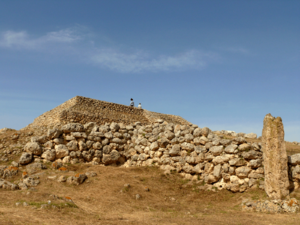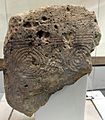Monte d'Accoddi facts for kids
Monte d'Accoddi is a very old archaeological site in northern Sardinia, an island in Italy. It was built during the Stone Age, around 4,000 to 3,650 BC. This site is famous for its huge stone platform. Many people believe it was used as an altar or a temple.
History of Monte d'Accoddi
Building the First Structure
The site was found in 1954. The first structure was built by people from the Ozieri culture. This was between 4,000 and 3,650 BC. It had a base that was 27 meters by 27 meters. It probably reached a height of 5.5 meters.
At the top, there was a platform about 12.5 meters by 7.2 meters. You could reach this platform using a ramp. No rooms or entrances have been found inside. This makes experts think it was an altar, a temple, or a step pyramid. It might also have been used to watch the sky, as it lines up with the main compass directions.
The Second Temple Structure
Between 3500 and 3000 BC, the old structure was covered. People used layers of earth and stone. Then, large blocks of limestone were added. This created a second, bigger platform. It looked like a step pyramid. This new structure was 36 meters by 29 meters. It was about 10 meters tall.
A new ramp, 42 meters long, was built over the older one. This second temple looks a bit like Mesopotamian ziggurats. It was built during a time called the Sub-Ozieri period.
Ancient Rituals and Discoveries
Archaeologists found signs that Monte d'Accoddi was used for animal sacrifice. This was during the chalcolithic period (Copper Age). They found bones from sheep, cattle, and pigs. These were found in almost equal amounts.
This site is one of the oldest places in Western Europe where sacrifices happened. It helps us understand how rituals developed in ancient times. Because of this, it's called "the most special cultic monument in the early Western Mediterranean."
Later Use and Abandonment
Around 2500 BC, pottery from the Bell Beaker culture appeared at Monte d'Accoddi. This pottery included bowls, cups, and other decorated vessels.
The site seems to have been left empty around 1800 BC. This was when the Nuragic age began. Some researchers, G. and M. Webster, believe the monument might have been built by people who came from Mesopotamia. This idea is based on the building style and items found.
Exploring the Surrounding Area
The area around Monte d'Accoddi has also been explored. It shows that this was a very important sacred place. Near the monument, there is a dolmen, which is a type of stone tomb. Across the ramp, there is a large menhir, which is a tall standing stone. Several other standing stones were once found nearby.
Archaeologists also found foundations of small buildings. These might have been homes. They also found mysterious carved stones. One impressive stone is shaped like an egg. It was then cut in a special curving way.
Reconstruction and Visiting
The monument was partly rebuilt in the 1980s. Today, you can visit Monte d'Accoddi. It is open to the public. You can find it near the old route of the SS131 highway. It is close to the small village of Ottava, about 14.9 km from Sassari. There is no public transport to the site. The opening times change throughout the year.
Images for kids
-
The dolmen and a carved boulder in the foreground
-
The menhir (standing stone)
-
One of the altars
-
Bell Beaker pottery, found at the site (c. 2500 BC).
See also
 In Spanish: Monte d'Accoddi para niños
In Spanish: Monte d'Accoddi para niños
















